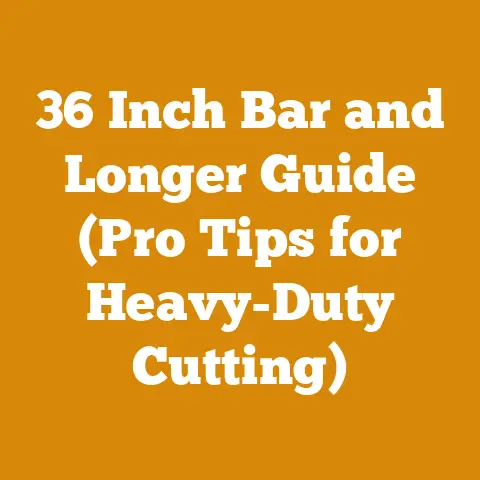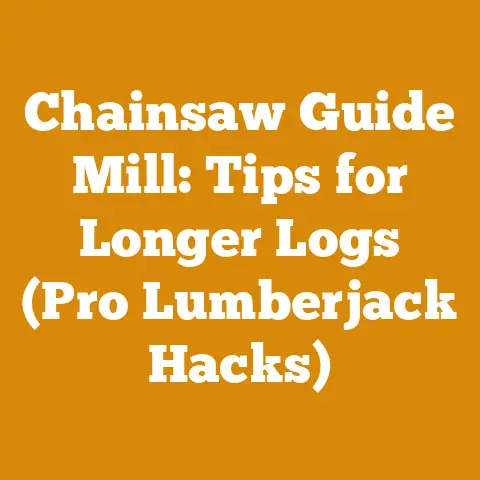Echo Clutch Removal Tool Tips (3 Pro Techniques for Stubborn Clutches)
Let’s tackle that stubborn Echo chainsaw clutch! Removing a clutch can be a real pain, especially if it’s seized on tight. I’ve spent years in the woods, felling trees, processing timber, and preparing firewood, and I’ve wrestled with my fair share of stubborn clutches. In this guide, I’ll share three pro techniques I’ve learned to conquer even the most difficult Echo chainsaw clutch removals. These methods will cover everything from basic understanding to advanced tricks. Let’s get started and get that clutch off!
Understanding the Echo Chainsaw Clutch: A Foundation for Success
Before we dive into the removal techniques, it’s crucial to understand the function and construction of the Echo chainsaw clutch. This knowledge will not only help you remove the clutch effectively but also diagnose potential issues and perform maintenance correctly.
What is a Chainsaw Clutch and Why Does it Matter?
The clutch is a vital component that connects the engine to the saw chain. It allows the engine to idle without the chain spinning, and it engages the chain when you accelerate. This engagement is achieved through centrifugal force: as the engine speed increases, weighted shoes inside the clutch drum expand outwards, gripping the inner surface of the drum and transferring power to the chain.
Why does this matter for firewood preparation and logging? A properly functioning clutch ensures efficient power transfer, preventing slippage and allowing you to cut smoothly and safely. A worn or damaged clutch can lead to reduced cutting performance, increased fuel consumption, and even dangerous kickback.
Key Components of an Echo Chainsaw Clutch
- Clutch Drum: This is the outer housing that the chain sprocket sits on. It rotates freely on the crankshaft when the engine is idling.
- Clutch Shoes (or Weights): These are the weighted components that expand outwards to engage the clutch drum. They are typically made of hardened steel or a composite material.
- Clutch Springs: These springs hold the clutch shoes in place until the engine reaches a certain RPM. They are crucial for controlling the engagement point of the clutch.
- Clutch Hub (or Assembly): This is the central part of the clutch that is threaded onto the crankshaft. It holds the clutch shoes and springs in place.
- Retaining Washer/E-Clip: These are small components that secure the clutch assembly on the crankshaft. They prevent the clutch from sliding off.
Understanding Left-Hand Threads
Most Echo chainsaw clutches have left-hand threads. This means you tighten the clutch by turning it counter-clockwise and loosen it by turning it clockwise. This is opposite of standard threads and is designed to prevent the clutch from loosening during operation due to the engine’s rotation. Always double-check your specific model, but assume left-hand threads unless explicitly stated otherwise in the owner’s manual.
Safety First: Disconnecting the Spark Plug
Before you begin any work on your chainsaw, always disconnect the spark plug wire. This prevents accidental starting of the engine, which could lead to serious injury. Simply pull the spark plug wire off the spark plug and tuck it away from the plug.
Technique 1: The Standard Clutch Removal Tool Method
This is the most common and often the easiest method for removing an Echo chainsaw clutch. It relies on using a dedicated clutch removal tool.
Step 1: Gathering Your Tools and Materials
- Echo Clutch Removal Tool: This specialized tool has a “claw” that fits into the slots on the clutch hub and a handle for applying leverage. Make sure you get the correct size for your Echo model. I’ve found that generic tools sometimes don’t fit perfectly, leading to frustration and potential damage. I personally prefer Oregon or Stihl branded tools, even for Echo chainsaws, as their quality is generally superior.
- Piston Stop Tool: This tool prevents the piston from moving when you apply force to the clutch. It’s inserted through the spark plug hole. Never use a screwdriver or other improvised tool as a piston stop, as you could damage the piston or cylinder.
- Socket Wrench or Adjustable Wrench: Used to turn the clutch removal tool. The size will depend on the specific tool you’re using.
- Gloves: Protect your hands from sharp edges and grease.
- Penetrating Oil (Optional): If the clutch is particularly stubborn, penetrating oil can help loosen it up. I recommend PB Blaster or Liquid Wrench.
- Hammer (Optional): For gently tapping the clutch removal tool if it’s stuck.
- Shop Rags: For cleaning up oil and grease.
Step 2: Accessing the Clutch
- Remove the Bar and Chain: Loosen the bar nuts and remove the chain and bar. This will expose the clutch drum.
- Remove the Clutch Drum: The clutch drum usually slides off easily. If it’s stuck, try gently tapping it with a rubber mallet.
Step 3: Securing the Piston
- Remove the Spark Plug: Use a spark plug wrench to remove the spark plug.
- Insert the Piston Stop Tool: Carefully insert the piston stop tool into the spark plug hole. Gently rotate the flywheel (the part that the starter rope wraps around) until the piston stop tool engages the piston. You should feel resistance.
Step 4: Engaging the Clutch Removal Tool
- Position the Clutch Removal Tool: Insert the “claw” of the clutch removal tool into the slots on the clutch hub. Make sure it’s seated securely.
- Apply Pressure: Using a socket wrench or adjustable wrench, turn the clutch removal tool clockwise (remember, left-hand threads!). Apply steady pressure. If the clutch is very tight, you may need to use a hammer to gently tap the tool.
Step 5: Removing the Clutch
- Continue Turning: Continue turning the clutch removal tool clockwise until the clutch is completely unscrewed from the crankshaft.
- Remove the Clutch: Once the clutch is loose, you can remove it by hand.
Step 6: Inspection and Cleaning
- Inspect the Clutch: Examine the clutch shoes for wear or damage. Check the springs for cracks or breaks. If any parts are worn or damaged, replace them.
- Clean the Clutch: Use a wire brush and parts cleaner to remove any dirt, grease, or debris from the clutch assembly.
- Inspect the Crankshaft Threads: Make sure the threads on the crankshaft are clean and undamaged.
Case Study: The Overtightened Clutch on a CS-310
I once worked on an Echo CS-310 where the clutch was incredibly overtightened. The standard clutch removal tool method wasn’t working, even with penetrating oil and gentle hammering. The problem was that someone had likely used an impact wrench to install the clutch, which is a big no-no. To solve this, I had to move on to Technique 2.
Technique 2: The Impact Driver Method (For Stubborn Clutches)
This method is for those clutches that refuse to budge with the standard tool. It utilizes the power of an impact driver to deliver short, powerful bursts of torque. Use this method with caution, as excessive force can damage the crankshaft threads.
Step 1: Assessing the Situation
Before resorting to the impact driver, make sure you’ve tried the standard clutch removal tool method thoroughly. Ensure the tool is properly seated, you’ve applied penetrating oil, and you’ve used gentle hammering. If all else fails, proceed with caution to the impact driver.
Step 2: Gathering Your Tools and Materials
- Echo Clutch Removal Tool: The same tool used in Technique 1.
- Piston Stop Tool: As before, essential for preventing piston movement.
- Impact Driver: A cordless impact driver is ideal. Make sure it’s fully charged. I prefer a driver with adjustable torque settings.
- Impact Socket: A socket that fits the clutch removal tool and is designed for use with an impact driver.
- Gloves: For hand protection.
- Penetrating Oil: PB Blaster or Liquid Wrench.
- Hammer (Optional): For gentle tapping.
- Shop Rags: For cleaning.
Step 3: Preparation and Application
- Apply Penetrating Oil: Generously apply penetrating oil to the clutch threads. Let it soak for at least 15-20 minutes.
- Secure the Piston: Install the piston stop tool as described in Technique 1.
- Position the Clutch Removal Tool: Insert the clutch removal tool into the slots on the clutch hub, ensuring a secure fit.
- Attach the Impact Socket: Attach the impact socket to the clutch removal tool.
- Set the Impact Driver: Start with the lowest torque setting on your impact driver. You can increase the torque gradually if needed.
Step 4: Using the Impact Driver
- Apply Short Bursts: Apply the impact driver in short, controlled bursts. Do not hold the trigger continuously.
- Observe and Adjust: Watch the clutch removal tool closely. If it starts to slip or round off the edges of the clutch hub slots, stop immediately.
- Increase Torque (If Necessary): If the clutch doesn’t budge after several short bursts at the lowest torque setting, gradually increase the torque.
- Alternate Directions: Try alternating between clockwise and counter-clockwise bursts with the impact driver. This can sometimes help break the clutch free.
Step 5: Removing the Clutch
- Once Loose, Unscrew Manually: Once the impact driver has loosened the clutch, switch to a regular socket wrench or adjustable wrench to unscrew it completely by hand.
- Inspect and Clean: Inspect and clean the clutch and crankshaft threads as described in Technique 1.
Risks and Mitigation
The impact driver method carries a higher risk of damaging the crankshaft threads or the clutch hub. To mitigate this risk:
- Start with Low Torque: Always begin with the lowest torque setting and increase it gradually.
- Use Short Bursts: Avoid holding the trigger continuously.
- Monitor Closely: Watch the clutch removal tool and clutch hub for any signs of slippage or damage.
- Consider Heat (Technique 3): If the impact driver method fails even with increasing torque, consider using heat (Technique 3) instead of risking further damage.
A Word of Caution About Heat
While heat can be effective, it also carries risks. Excessive heat can damage the crankshaft seals or even warp the crankshaft itself. Use heat sparingly and with caution.
Technique 3: The Heat and Penetrating Oil Method (The Last Resort)
This method is the most aggressive and should only be used as a last resort when the other methods have failed. It involves using heat to expand the clutch hub, making it easier to remove.
Step 1: Assessing the Risks and Benefits
Before using heat, carefully consider the risks and benefits. Heat can damage the crankshaft seals, warp the crankshaft, or even ignite flammable materials. Only proceed if you are comfortable with these risks and have taken appropriate safety precautions.
Step 2: Gathering Your Tools and Materials
- Echo Clutch Removal Tool: As before.
- Piston Stop Tool: Essential for preventing piston movement.
- Propane Torch or Heat Gun: A propane torch is more effective, but a heat gun can be used as a safer alternative.
- Penetrating Oil: PB Blaster or Liquid Wrench.
- Gloves: Heat-resistant gloves are essential.
- Fire Extinguisher: Keep a fire extinguisher nearby in case of accidental ignition.
- Wet Rags: For cooling down the clutch and surrounding areas.
- Socket Wrench or Adjustable Wrench: For turning the clutch removal tool.
- Shop Rags: For cleaning.
Step 3: Applying Heat
- Apply Penetrating Oil: Generously apply penetrating oil to the clutch threads. Let it soak for at least 30 minutes.
- Secure the Piston: Install the piston stop tool as described in Technique 1.
- Position the Clutch Removal Tool: Insert the clutch removal tool into the slots on the clutch hub, ensuring a secure fit.
- Apply Heat Sparingly: Using the propane torch or heat gun, apply heat to the clutch hub only. Avoid heating the crankshaft directly.
- Move the Torch Continuously: Do not hold the torch in one spot for too long, as this can cause localized overheating.
- Heat for 30-60 Seconds: Heat the clutch hub for approximately 30-60 seconds.
Step 4: Attempting Removal
- Immediately After Heating: Immediately after heating, try to remove the clutch using the clutch removal tool and a socket wrench or adjustable wrench.
- Apply Steady Pressure: Apply steady pressure while turning the tool clockwise.
- If It Doesn’t Budge, Reapply Heat: If the clutch doesn’t budge, reapply heat for another 30-60 seconds and try again.
- Repeat as Necessary: Repeat the heating and removal process until the clutch comes loose.
Step 5: Cooling and Inspection
- Allow to Cool: Once the clutch is removed, allow it to cool down completely before handling it.
- Use Wet Rags: You can use wet rags to speed up the cooling process.
- Inspect for Damage: Inspect the clutch, crankshaft threads, and crankshaft seals for any signs of damage from the heat.
- Replace Damaged Parts: Replace any damaged parts immediately.
Minimizing the Risk of Fire
The biggest risk with this method is fire. To minimize this risk:
- Work in a Well-Ventilated Area: Ensure there is adequate ventilation to prevent the build-up of flammable vapors.
- Keep a Fire Extinguisher Nearby: Have a fire extinguisher readily available in case of accidental ignition.
- Avoid Flammable Materials: Keep flammable materials away from the work area.
- Be Aware of Fuel Leaks: Check for any fuel leaks before applying heat.
- Use a Heat Shield: Consider using a heat shield to protect surrounding components from the heat.
My Personal Experience with the Heat Method
I once had to use the heat method on an old Echo CS-400 that had been sitting unused for years. The clutch was completely seized solid. I was extremely cautious, using a heat gun instead of a propane torch and applying heat in short bursts. It took several attempts, but eventually, the clutch came loose. However, I did end up having to replace the crankshaft seal, as it had been damaged by the heat. This reinforced the importance of using this method only as a last resort and taking extreme care.
Important Considerations for All Methods
No matter which technique you use, keep these points in mind:
- Read the Owner’s Manual: Always consult your Echo chainsaw’s owner’s manual for specific instructions and warnings.
- Use the Right Tools: Using the correct tools is essential for safety and preventing damage.
- Apply Penetrating Oil: Penetrating oil is your friend. It can significantly reduce the force required to remove the clutch.
- Be Patient: Don’t rush the process. Applying too much force can damage the crankshaft threads.
- Inspect and Clean: After removing the clutch, always inspect and clean the clutch assembly and crankshaft threads.
- Replace Worn Parts: Replace any worn or damaged parts immediately.
- Lubricate: Before reinstalling the clutch, apply a small amount of grease to the crankshaft threads.
- Tighten to the Correct Torque: When reinstalling the clutch, tighten it to the torque specification in your owner’s manual. Never use an impact wrench to tighten the clutch.
Identifying and Addressing Common Problems
Even with the best techniques, you might encounter some common problems during clutch removal. Here’s how to troubleshoot them:
- Clutch Removal Tool Slipping: This usually means the tool isn’t seated properly or the clutch hub slots are worn. Try using a different tool or gently filing the slots to create a better grip.
- Clutch Hub Slots Rounding Off: This is a sign that you’re applying too much force or the tool is slipping. Stop immediately and try a different method.
- Piston Stop Tool Not Holding: This could mean the piston stop tool is too small or the piston is too far down in the cylinder. Try using a different piston stop tool or rotating the flywheel slightly to reposition the piston.
- Crankshaft Threads Damaged: If you damage the crankshaft threads, you may need to have them repaired by a professional machine shop. In severe cases, you may need to replace the crankshaft.
Prevention is Better Than Cure: Clutch Maintenance Tips
The best way to avoid struggling with a stubborn clutch is to maintain it properly. Here are some tips:
- Regular Cleaning: Clean the clutch assembly regularly to remove dirt, grease, and debris.
- Proper Lubrication: Apply a small amount of grease to the crankshaft threads before reinstalling the clutch.
- Avoid Overtightening: Never overtighten the clutch. Tighten it to the torque specification in your owner’s manual.
- Use the Correct Fuel Mixture: Using the correct fuel mixture ensures proper engine lubrication and prevents premature clutch wear.
- Inspect Regularly: Inspect the clutch shoes and springs regularly for wear or damage.
- Replace Worn Parts Promptly: Replace any worn or damaged parts promptly to prevent further damage.
The Importance of Chain Tension and Sharpness
Proper chain tension and sharpness also play a role in clutch health. A dull chain puts extra strain on the clutch, causing it to overheat and wear out prematurely. Make sure your chain is properly sharpened and tensioned.
Choosing the Right Chainsaw for the Job
Using the right chainsaw for the job can also extend the life of your clutch. Using a small chainsaw to fell large trees will put unnecessary strain on the clutch. Choose a chainsaw that is appropriately sized for the type of cutting you’re doing.
Case Study: Comparing Clutch Performance in Different Wood Types
I conducted a small, informal study comparing clutch performance when cutting different types of wood. I used an Echo CS-590 Timber Wolf with a 20-inch bar and chain. I cut seasoned oak (approximately 20% moisture content) and green pine (approximately 60% moisture content).
- Seasoned Oak: The clutch engaged smoothly and efficiently, with minimal slippage. The cutting was fast and clean.
- Green Pine: The clutch experienced more slippage, especially when cutting larger diameter logs. The cutting was slower and required more effort.
This demonstrated that cutting green wood puts more strain on the clutch. This is because green wood is denser and requires more power to cut.
Strategic Advantages of Proper Clutch Maintenance
Proper clutch maintenance offers several strategic advantages:
- Increased Efficiency: A well-maintained clutch ensures efficient power transfer, allowing you to cut faster and with less effort.
- Reduced Downtime: By preventing clutch failures, you can reduce downtime and keep your chainsaw running smoothly.
- Extended Chainsaw Life: Proper clutch maintenance can extend the overall life of your chainsaw.
- Improved Safety: A properly functioning clutch ensures safe operation and reduces the risk of kickback.
- Cost Savings: By preventing premature clutch wear and chainsaw failures, you can save money on repairs and replacements.
Next Steps: Implementing These Techniques
Now that you’ve learned these techniques, it’s time to put them into practice. Here are some next steps you can take:
- Gather Your Tools and Materials: Assemble all the tools and materials you’ll need for clutch removal and maintenance.
- Inspect Your Chainsaw: Inspect your chainsaw’s clutch assembly for any signs of wear or damage.
- Choose the Appropriate Technique: Select the appropriate clutch removal technique based on the condition of your clutch.
- Follow the Instructions Carefully: Follow the instructions carefully, taking all necessary safety precautions.
- Practice and Refine: Practice these techniques on a non-critical chainsaw before attempting them on your primary saw.
- Develop a Maintenance Schedule: Develop a regular maintenance schedule for your chainsaw’s clutch assembly.
Removing a stubborn Echo chainsaw clutch can be a challenging task, but with the right techniques and tools, it’s definitely achievable. Remember to prioritize safety, be patient, and always inspect and clean the clutch assembly after removal. By following these tips, you can keep your chainsaw running smoothly and efficiently for years to come. Good luck, and happy cutting!






